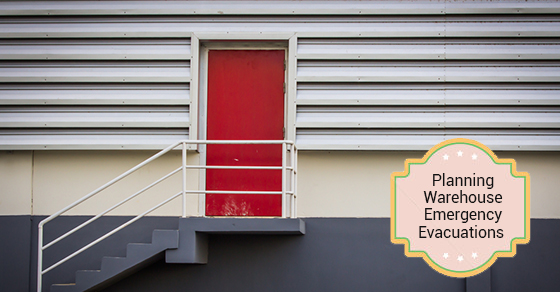Emergency planning is important for any business, and in warehouses it is particularly important.

With so many people in one location along with tonnes of goods and equipment, the risk of injury, loss of life and damage to property in the event of an emergency is that much greater. However there are very specific actions you can take to ensure that personnel are evacuated quickly and safely. One of the most important is ensuring that everyone is aware of what their roles and responsibilities are in the event of an emergency.
When An Evacuation Is Necessary
Any unforeseen event, whether manmade or natural, that endangers the lives and physical well being of staff/workers warrants and evacuation. This could include earthquakes, fires, explosions, storms, toxic gas leaks, or any type of civil disturbance.
Planning for an Emergency
Any emergency plan must have the following:
- Policies and procedures for evacuating the warehouse, such as designated emergency exits, assembly areas, and documentation outlining these procedures
- Coordination among departments of designated roles in the event of an emergency
- A list of contacts for further information and direction in the event of an emergency. This may include external contacts such as the fire department and health services
- A list of emergency personnel who may be required to remain in the building after everyone else has left
- Designated rescue and first aid staff
- A clear chain of command in the event of an emergency
- A method of communication to alert employees and give direction
Although not essential, it is also good to have alternative off site locations for essential documents or communications.
Roles Responsibilities in the Event of An Emergency
All staff must be clear of what needs to be done in the event of an emergency and what their particular roles are. This is crucial to the success of any emergency planning as it minimises confusion and risk.
When outlining an evacuation policy, there must be a clear chain of command. A trusted and responsible employee must be given authority to make decisions in the event of an emergency, and everyone else must be aware of that employee’s authority.
Employees must be thoroughly trained in all emergency procedures that are relevant to them. Set aside a specific time for this during the work day. Often it can be done during morning assembly. Employees should be trained to alert their supervisors/managers of anything that is suspicious or dangerous. When it comes to handling dangerous material, rescue and first aid, this should be left to trained personnel.
Alarms and Drills
Employees should know what the alarm should sound like in an emergency. Drills play a critical role here and there should be a drill at least once a year. Emergency exits should never be blocked and routes should be clearly marked. If there has been a change in emergency plans, protocols or designated responsibilities, everyone should be informed.

